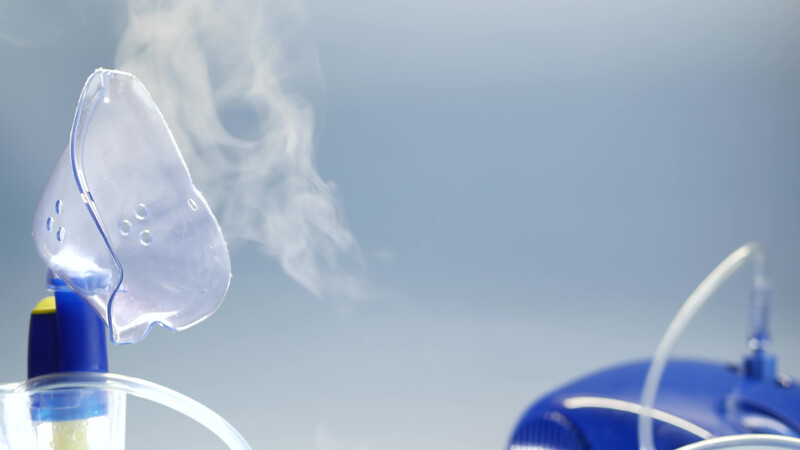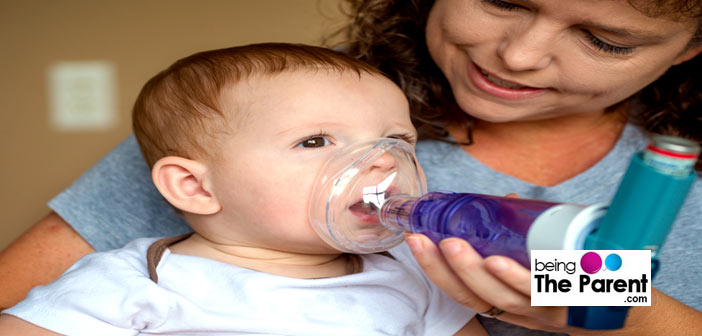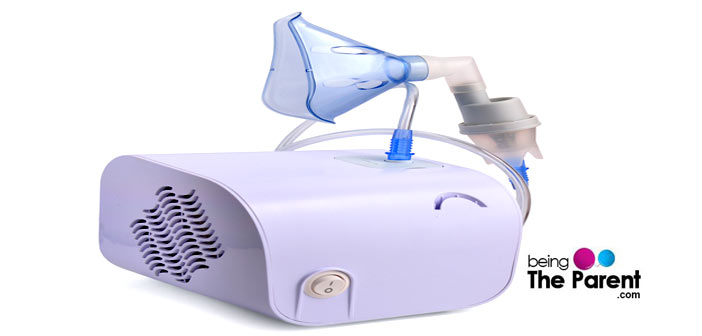
If your baby’s cold or cough leads to chest congestion or breathing problems, the chances are that his doctor would prescribe nebulization. The use of nebulizer is much more effective for children’s respiratory problems as children are too small to operate an inhaler themselves.
Since children are more often than not very uncomfortable when they start using nebulization, parents usually second-guess themselves and wonder if it is the best treatment option. It is. Read on to understand what is the use of nebulizer, when to use it, how to use it effectively with your child, and other related topics.
1. What Is A Nebulizer?
2. What Medicines Are Used In A Nebulizer?
3. How Often Do You Need To Nebulize The Child?
4. When To Use of Nebulizer?
5. What Are The Side Effects Of Nebulizers?
6. Should I Buy A Nebulizer?
7. What Are The Different Kinds Of Nebulizers Available In Indian Market?
8. Tips To Help Your Child Use Of Nebulizer
What Is A Nebulizer?
A use of nebulizer is a machine that converts liquid asthma medicine into a breathable mist. It is a machine that transforms the medicine into mist and is inhaled by the child to reach the lungs to provide relief in breathing. It has a tube, a container in which medicine is filled, and a mask that is put on the child’s face.
Most nebulizers come with three parts: the machine itself, a medical dispenser (a.k.a. a nebulizer cup), and a face mask. Once you put the required medicine in the medical dispenser, you connect one end of it to the machine and the other end to the facial mask with the tubes provided. You fit the mask on the child’s face.
Once you switch on the machine, the liquid medicine in the dispenser is converted into the mist (it is vaguely white in color), which comes out of the mask. All your child needs to do is sit still and breathe normally for 5-10 minutes or till all the liquid medicine is converted. The fact that it involves very few “actions” from your child is what makes nebulization very popular. It ensures both the doctor and the parents that the medicine has reached the child’s airways without a doubt.
Some parents have their own preconceived notions about these medicines, and they avoid giving it to their child. Some of them believe that the use of nebulizer would make their child habitual of its use, and therefore, they don’t nebulize their child and ask the doctors for antibiotics and other medicines instead.
What Medicines Are Used In A Nebulizer?
Your child’s doctor would prescribe a medicine that is most suited for the treatment of your child’s condition. The commonly prescribed medicine groups are:
- Corticosteroids: These drugs reduce inflammation of the breathing passage swelling in the bronchial tube and mucus production
- Bronchodilators: Primarily used to address asthma symptoms, these drugs are used on need basis
- Non-steroid anti-inflammatory medications: These drugs can have some side effects, but they help to reduce the inflammation of the breathing passage. They do not control the symptoms of asthma as such
- Saline solutions of different concentrations
Although it is difficult to generalize, the medication prescribed depends on the severity of your child’s condition:
- Only saline-based solutions for smaller problems
- Non-steroid medications, for slightly more severe cases
- Steroid-based medications (like Asthalin) for SOS situations

How Often Do You Need To Nebulize The Child?
Again, it depends on the severity of your child’s respiratory problems. Your doctor might suggest as often as “once in every 2 hours” to as infrequent as “only before sleep in the night.” If your child has pediatric asthma, he will get allergic and face the almost regular cold, sneezing, and running nose problems, which eventually becomes so strong that he has a problem in breathing. This is where the doctors recommend the use of nebulizer for infants as it is the easiest way to provide medicine and help your child. Pediatric asthma, as the doctors say, is not a lifelong condition. It stays till the age of five to six years, and as the child becomes strong in immunity, it gradually reduces and vanishes away.
When To Use of Nebulizer?
As mentioned before, the use of nebulizer is very effective in the treatment of respiratory problems like allergic asthma. It helps in opening up the inflamed airways of your child, helping them breathe easily instantly. However, you should always check with your child’s pediatrician before you start nebulization. You should never self-medicate based on previous experience.
Some pediatricians allow nebulization with saline solution as an easy alternative to steam inhalation. Please check with your child’s doctor if you can do this without consulting him occasionally.
What Are The Side Effects Of Nebulizers?
Nebulizer – is equipment – is quite safe to use. In fact, it is safer than your steam inhaler as there is no risk of boiling water spillage. The mist that comes out of the nebulizer is slightly cold – so again, there is no danger of burning, unlike steam.
The side effects, although very rare and few, are mostly from the medicines used, especially if your child has been asked to take inhalable steroids. Some of the less serious side effects are:
- Dry or irritated throat
- Unpleasant taste in the mouth
- Nausea
- Heartburn
Some of the rarer, but more serious side effects are:
- Bleeding nose
- Dizziness
- Stomach pain
However, rest assured, these side effects are quite rare.
Should I Buy A Nebulizer?
Most hospitals have nebulizing equipment for out-patients. It is entirely up to you if you want to take your child to the hospital for each nebulization or buy the equipment at home. The advantage of the hospital is that it is more pocket-friendly, and there are trained nurses who would help you with the process. However, some kids are terrorized with nebulization and face mask, so being in a hospital environment where they are usually taken for vaccination shots might make things worse.
The advantage of buying nebulizer is that you can nebulize in the comfort of your home. It avoids multiple trips to the hospital with a sick child, especially if it needs to be administered more than three times a day. Your child is less likely to be cranky and uncooperative at home. However, most good nebulizers cost Rs2,000 or above, and medications – especially steroid ones – are expensive.

What Are The Different Kinds Of Nebulizers Available In Indian Market?
There are both battery-operated and electrical nebulizers available in the market. In India, however, electric-powered tabletop models are more widely used. The most popular brands are Philips and Omron. However, there are other options available such as Dr.Morepen, Rossmax, and Equinox. Each of these brands offers different models with different pricing options. While most of them work in a similar fashion, some, like Philips, are known to be more user-/child- friendly than others.
Since many of us live in apartment communities, it is very common to see families sharing one nebulizer machine. This is acceptable. However, ensure that you buy a facial mask exclusively for your child, which under no circumstances, should be shared.
Tips To Help Your Child Use Of Nebulizer
- Avoid mask-o-phobia: Most kids are scared of the mask. So make the mask sound exciting and adventurous. Say that it is the same as the one a jet-fighter pilot wears. Or say that it is an astronaut mask. You can even masks that are shaped like animals for added fun
- Make it a routine: Kids get adjusted to routines quickly. Doing it every day at the same time will help them cope better
- Personalize the machine: Allow your child to decorate the nebulizer machine with artwork or stickers of their choice
- Make it fun: Make the time the child has to sit still as fun and to engage as possible. Sing songs, read stories, watch a video or two. Do not engage in activities like painting where your child has to look down (this will change the mask position and compromise the amount of medicine that goes into the airways)
- Help them sit comfortably: See what works for your child. Maybe a high chair? Or maybe your lap? Ensure they are sitting comfortably in a position they can maintain for 10-15 minutes. Remember that if the mask is away from the face even by 1 cm, the amount of medicine that reaches the child’s lungs reduces drastically
- Encourage them to mimic your deep breathing: You breathe deeply and encourage them to mimic your breathing!
- Wear a mask: Most nebulizing kits come with two masks. You wear the other one so that the child does not feel alone
- Be positive about treatment
The use of nebulizer, though being safe but should be properly used to administer medicine. The doctor should always be consulted before the use of a nebulizer machine. The method of nebulizing and the number of times a child should be nebulized should always be done on a doctor’s prescription for the safety and benefit of your child.

